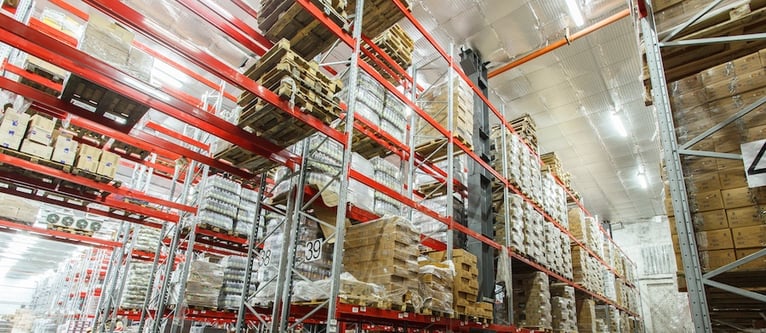The supply chain is a fascinating snapshot of the power of business: a sleek, ever-evolving product of ongoing collaborations, careful adjustments and built-in tolerance that can withstand a startling amount of outside forces — when properly balanced.
The trick to manifesting a supply chain that resembles that description (rather than a hastily-cobbled handful of stopgaps) is found in a single solution: smart design.

Designing your supply chain - like all things worth having in business - requires an upfront effort, and it starts with a meaningful assessment of your supply chain as it currently operates.
Step #1: Start Broad, Zoom In
Just like a mechanic running diagnostics on a car, the best place to start is the most obvious symptoms or issues, gradually working into more granular detail to determine the culprit.
At your end of the supply chain, what could use improvement?
Here are a few examples of common supply chain issues at the warehouse level:
Your products or components often arrive late or incomplete.
When your incoming vendor deliveries don't arrive on time, that starts a chain reaction ending with disappointed consumers. Disappointed consumers mean less repeat business.
While you can hold vendors accountable after the fact, transparent inclusions like an automated shipment notification system will give you advance notice so you can place orders elsewhere, when needed.
Your vendor orders are often incorrect and need to be returned.
The other side of the vendor error coin: orders arrive on time, but don't contain the right items. This scenario is no better than a late order, as far as your customers are concerned, and takes additional effort from your staff to arrange a return and replacement shipment.
Part of good network design is incorporating additional options for situations like vendor shortfalls, enabling a "plan B"-style branched supply chain to remain flexible and consistent.
Your "reverse logistics," or returns, are taking up a lot of time.
If your company has a return policy, processing returns
Addressing this facet of your supply chain might mean discussion with a third party logistics provider to extend return label printing to customers, or the option to connect automated customer return tracking into your warehouse-level dashboard.
Your shipping costs are sky-high.
Market influences, such as the high price of oil, are an unfortunate reality of any company that ships physical goods.
Smart supply chain design, particularly proactive logistics partnerships, will help ease the pinch of this unavoidable cost.
If your company hasn't completed a thorough audit of your packing and shipping processes in recent history, you should start scheduling checkups annually, if not more often. Recent changes within the shipping industry have introduced complex obstacles, such as dimensional weight pricing, or DIM.
If your company is still using "volume heavy" boxes under the belief only weight matters, you're probably paying more than you need to.
Step #2: Gather Your Data
It's human nature to address the problems closest to you first. Decision-making individuals, or even teams, will naturally gravitate toward fixing issues unique to their department before moving on to other operational concerns. They understand those problems, after all, so solutions here take on a "low-hanging fruit" effect.
While this approach might run into a happy accident--the department in question having the worst issues--chances are it represents working on priorities out of order.
Data, as they say, doesn't lie. It's a much better place to start when working on a proverbial plan of attack. While you might need to do a little footwork and manually gather data the first few times, work in smart data collection practices from the start.
Data won't just show you the target area and scope of various supply chain inefficiencies; it could also signal the need for foundational changes.
For example: if the data shows a vendor consistently underperforming, or overly-complicated warehouse pick/pack procedures, it will help clarify which difficulties are core issues to be corrected versus which are merely trickle-down effects of a larger problem.
Devoting time and effort into fixing symptoms without identifying their causes is as problematic (on a long enough timeline) as ignoring the problem altogether.
You can also use data to hold vendors and service providers accountable for contractual targets: if you're paying for a service threshold and not receiving it, you're essentially giving a bonus for poor performance!
Step #3: Create and Use Case Studies
When you communicate your performance goals, come prepared with a concrete set of examples to convey your needs rather than a series of abstracts.
For example, create a specific scenario - such as reducing the cost and/or difficulty to ship a 5-pound box from your warehouse to a customer in Saint Louis - to demonstrate the effects of smarter supply chain design.
This approach will highlight the result of the changes you'd like to make, which gives you the buy-in you need from the C-suite, warehouse, and supply chain partners, alike.
If you continue to discuss abstracts instead of case studies, you risk losing that buy-in and could fail to get the support you need to implement necessary changes. Be specific, bring examples of problem areas, and come to your meetings armed with real-world examples of wasteful practices.
To Sum It All Up
To choose the right network design approach for your supply chain means, you need to hit all three target steps:
- Assessment
- Data-based decision-making
- Comprehensive communication with implementation partners
Think of these points as pillars that hold the entire operation stable, similar to the seat of a stool. Take away one, and the surface is no longer even. It can't support itself. It collapses.
Ensure all three are in place, however, and you will always have a trustworthy, weight-bearing solution that can support the heavy demands of a business supply chain.



